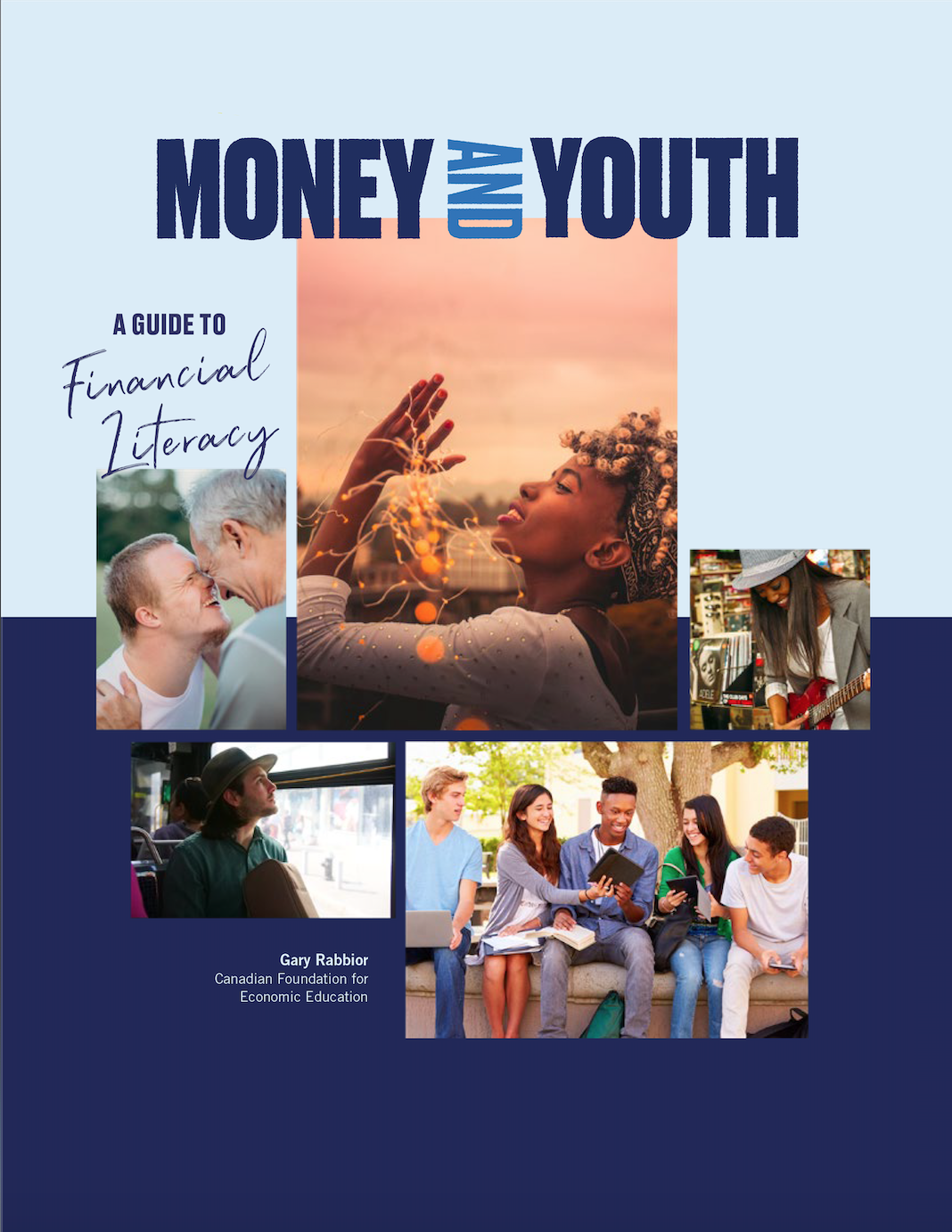The following lessons can be used as instructional material for Modules 11 and 12 of Money and Youth - Borrowing Money and Getting and Managing Credit.
Relevant Subjects and Topics:
Money, borrowing money, credit cards, cost of credit, living within one’s means, managing money, making money decisions, being a wise consumer
Overview and Background:
More than 75% of Canadians have credit cards, and those who do average 2.5 credit cards per person with an average debt of over $1,200. It is obvious that students need to develop an awareness and understanding of the use of credit and how it can affect their adult lives. As they mature they will be bombarded with offers for credit cards and, if they do not handle the situation correctly, they could find themselves in serious financial difficulty. Far too often the true costs of using credit are not seen until after the commitment has been made. It is important for students to develop an awareness of these issues so they can enter their independent consumer years fully prepared to handle the situation.
This unit uses some of the material found in the lesson plans entitled “Thinking about Credit” found at http://learningtogive.org/lessons/unit486/lesson2.html#lesson. See more information on the “Learning to Give” organization at the end of this lesson.
Outcomes:
At the end of this lesson, students will be able to:
- Understand that there are ways to pay for things over time
- Identify places where you can borrow money
- Understand that there are costs associated with borrowing money
- Describe what a credit card is
- Describe how a credit card works
- Understand that there are different kinds of credit cards
- Explain what “living within your means” means
- Explain the importance of a credit rating
Time for Implementation:
Four class periods – approximately 60 minutes each
Teaching and Learning Strategies:
Period One: 60 minutes
- Begin the lesson by holding up a credit card and asking the students to identify it.
- Ask the students if their family has a credit card.
- Ask them how many of their families have more than one credit card.
- Have them identify the types of credit cards they know.
- Ask them to explain why they think credit cards are so popular.
- Ask them to define the term “credit” - the opportunity to borrow money or receive goods or services in return for a promise to pay later.
- Ask them if it is a good thing to use a credit card.
- Have them suggest the pros and cons of owning a credit card and compile a list as they make their suggestions.
- Have them guess what percentage of Canadians own credit cards and how many the average cardholder has. Answers – over 75% of Canadians have credit cards and the average cardholder has 2.5 cards.
- Tell them that the average card holder owes over $1,200 on their credit cards and ask them if they think that is a lot of money to owe.
- Arrange the students in groups of four to six students and, stressing with them the fact that using credit cards is a form of borrowing money, ask the groups to discuss reasons why people borrow money.
- Take up their responses and have them compare their answers to the ones on pages 148 to 150 of Money and Youth.
- Review with them the types of loans found on page 151 of Money and Youth.
- After this brief discussion, tell them that there is a general rule to make sure that you are not using the wrong kind of credit and using it too much.
- Provide them with a copy of the handout “Using Credit Wisely – the 20/10 rule” found on the link listed below under “Handouts/Resources” and allow them time to read it. If you are not able to provide a copy of this handout to the students, explain to them that there is a 20/10 rule regarding borrowing. This rule states that you should keep your borrowing total below 20% of your annual after tax income and you should keep your monthly payments on all loans to no more than 10% of your monthly after tax income.
- To ensure that they have understood the concept give them the following question to answer:
- Clare wants to buy a wide-screen TV that sells for $2,000. She will make a down payment of $1,000 and then six monthly payments of $200.
- Applying the 20/10 rule: If Clare has a net monthly income of $1,400 and already pays $100 per month for a furniture installment loan, would you recommend that she purchase the TV?
- Allow the groups time to answer the question and then have them report their decision, explaining their answer.
- Ask them to look again at Clare’s possible TV purchase.
- Ask them to determine how much it actually would have cost Clare if she had bought the TV under the terms she was considering.
- Once they see that Clare actually would have paid $2,200 for the TV, explain to them that the terms and conditions under which you purchase something can greatly affect the final price.
- With this as background, have the groups go to the website “It Costs What?” listed under “Handouts/Resources” below and have them complete the online activity. (If computers are not available for the groups, use a common computer and lead the class through the activity.)
- Ask them now to complete the option of “choosing wisely” at this time.
- Inform them that they have the remainder of the period to complete the online game.
Period Two: 60 minutes
- Begin the lesson by reviewing the case files pages from “It Costs What?” to reinforce the previous lesson’s information about the costs of credit.
- Explain to the students that there are certain factors which affect the cost of a loan.
- Have them suggest what they believe those factors are and ensure that the following are on their list: your credit history and credit rating; who is lending the money; your history with that organization; how much you are borrowing.
- Indicate to the students that the focus of this lesson will be on credit cards and how they work.
- Provide the following explanation to the students:
Some credit cards, such as American Express, require you to pay off all of your charges each month. As a benefit, they usually have no finance charge, and sometimes no maximum limit. Most cards, including Visa and MasterCard, offer what is known as revolving credit. This means they let you carry a balance, on which they charge interest (finance charges), and they require you to make a minimum payment. The minimum payment is usually about 5 percent of your current balance or $10 - whichever is more.
- Review the explanation to ensure that the students understand how credit cards work.
- With this as background, have them look at the following two examples that show what you pay will vary depending upon your balance and the interest rate.
- High-rate card - Suppose you charge $1,000 on a 23.99-percent credit card. After that, you make no further charges and pay only the minimum each month. The payment will start at $51 and slowly work its way down to $10. You'll make 77 payments over the next six years and five months. By then, you will have paid $573.59 in interest for your credit privilege.
- Low-rate card - If you charge that same $1,000 on a 9.9-percent fixed-rate card, the minimum monthly payment will start at $50.41 and go down to $10. You'll make 17 fewer payments, finishing in six years and paying $176 in interest. This saves you almost $400!
- Inform the students that they are now going to evaluate a specific credit card.
- Using one of the two websites listed below in “Handouts/Resources” under “Credit Card Websites” assign one credit card to each group and have them research it and gather the following information about the card: (NOTE: If computer access will not be available to the students print out the information so that each group will have one card to study.)
- What type of card is it?
- Who is it designed for?
- What is the annual percentage rate?
- What are the benefits offered?
- What, if any, is the annual fee?
- Are there promotions to get you to take out that card – that is, do they offer a lower rate for the first short period of time?
- If there is a promotion for the new card holders how long does it last and then what happens?
- Once they have completed the task, have each group design a poster that they would use to promote that credit card. Provide a piece of Bristol board for them to use for their poster.
- Allow them the remainder of class time to design their poster and assign tasks for gathering any necessary materials from home to complete the poster.
- Inform them that they will have 20 minutes at the beginning of the next period to complete their poster and then they must be prepared to present it to the class.
Period Three: 60 minutes
- Begin the lesson by allowing the students the promised 20 minutes to prepare their posters and then have each group present their poster.
- Once this has been done, hold a plenary session with the class to discuss which is seen as the best choice for a credit card and why.
- Once they have selected a card, ask the groups to determine what it would cost if you owed $1,200 for a year on that card. Make certain that they take into account annual fees.
- Ask them also to identify any rewards they would receive for having that card.
- Indicate to the students that there is also another thing known as your CREDIT RATING that affects the rates that you will have to pay and may even determine if you would be given a credit card. Tell them that will be the focus of the next lesson.
Period Four: 60 minutes
- Begin the lesson by asking the students to take a moment and write down what factors would determine whether or not they would lend money to another person.
- Hold a brief plenary session and make a list of their suggested factors.
- Once this has been done see if their list can be grouped into the “3 Cs” of credit worthiness – Capital, Character and Capacity.
- Ask the students to explain what they think is meant by each of these terms and, using the explanations on pages 160 to the top of 164 of Money and Youth ensure that they have a clear understanding of each term.
- Inform the students that how they score in these three basic areas will affect their credit rating and their ability to borrow money.
- Explain credit rating using the following definition:
Credit rating is an assessment of the credit worthiness of individuals and corporations. It is based upon the history of borrowing and repayment, as well as the availability of assets (essentially what you own) and extent of liabilities (essentially what you owe).
- Show the students the following example (“Angela’s Actions and her credit score” – (http://www.thirteen.org/finance/educators/p-lesson3_org2.html) of how what you do with your finances affects your credit rating and review Angela’s actions and how they affect her credit rating. (It is also found as a hyperlink under “Handouts/Resources” below.)
- Once this has been completed, have the students discuss as a class what they think about Angela’s spending habits and what she should do to make certain that she is making wise choices.
- For homework, assign the following two questions which should be completed and handed in at the beginning of the next class period:
- Would you own a credit card if you could? Why or why not?
- If you were to own a credit card what five things would you do to make certain that you used it responsibly and kept your debts under control?
Evaluation:
- Period 3 – the posters could be handed in for evaluation.
- Period 4 – the written response to the assigned two questions should be handed in for evaluation of how well the student has understood the strategies of careful credit management.
- The homework assignment could be evaluated.
- Peer evaluation of group activities could also be done using the peer evaluation found below under “Handouts/Resources.”
Modifications or Suggestions for Different Learners:
- The group activities and creative assignment with the poster allow students with different skills and abilities to contribute in a meaningful way.
Handouts/Resources:
About Learning to Give:
- EDUCATES youth about philanthropy, the civil society sector, and the importance of giving their time, talent and treasure for the common good (knowledge),
- DEVELOPS philanthropic behavior and experience (skills), and,
- EMPOWERS youth to take voluntary citizen action for the common good in their classrooms, their lives and their communities (behavior).
- Learning to Give educates youth about the importance of philanthropy, the civil society sector, and civic engagement. The Learning to Give website offers over 1,600 K-12 lessons and educational resources for teachers, parents, youth workers, faith groups and community leaders free of charge.
- generationOn is a global youth service movement igniting the power of all kids to make their mark on the world. Its mission is to inspire, equip and mobilize youth to take action that changes the world and themselves through service. Newly created within the Points of Light Institute, generationOn brings the nation's leading youth service organizations and programs under one umbrella including New York-based Children for Children, The LEAGUE, Learning to Give and Points of Light's KidsCare Clubs, HandsOn Schools and HandsOn Network's youth-driven programs.
- With service-learning and volunteer action at its core, generationOn mobilizes the energy, ingenuity and compassion of young people, starting at an early age, to discover their power and potential to solve real world problems through service. http://learningtogive.org/about/
Additional Related Links:
Additional Possible Activities:
- As a reaffirming activity to this unit, the students could visit The City - https://www.canada.ca/en/financial-consumer-agency/services/the-city/city-benefits.html and register and complete the Reality Check activity which will give them a good understanding of lifestyle and what it takes to afford that chosen way of living. If computer access is not available for the students to complete this task, then using a classroom computer and projection equipment, complete the activity together as a class.
- The students could look at a monthly credit card statement and decipher the information.
- The students could develop a mock monthly budget to examine what types of expenses would exist and how they would have to manage their finances to avoid a debt situation.
- The students could make a pretend purchase of an article that would require financing and determine, making just minimum monthly payments, what that article would truly cost.




















